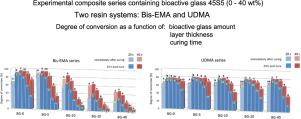当前位置:
X-MOL 学术
›
Dent. Mater.
›
论文详情
Our official English website, www.x-mol.net, welcomes your
feedback! (Note: you will need to create a separate account there.)
Curing potential of experimental resin composites filled with bioactive glass: A comparison between Bis-EMA and UDMA based resin systems.
Dental Materials ( IF 4.6 ) Pub Date : 2020-04-27 , DOI: 10.1016/j.dental.2020.03.015 Matej Par 1 , Nika Spanovic 2 , Dirk Mohn 3 , Thomas Attin 4 , Tobias T Tauböck 4 , Zrinka Tarle 1
Dental Materials ( IF 4.6 ) Pub Date : 2020-04-27 , DOI: 10.1016/j.dental.2020.03.015 Matej Par 1 , Nika Spanovic 2 , Dirk Mohn 3 , Thomas Attin 4 , Tobias T Tauböck 4 , Zrinka Tarle 1
Affiliation

|
OBJECTIVES
To evaluate the degree of conversion, light transmittance, and depth of cure of two experimental light-curable bioactive glass (BG)-containing composite series based on different resin systems.
METHODS
Experimental composite series based on either Bis-EMA or UDMA resin were prepared. Each series contained 0, 5, 10, 20, and 40wt% of BG 45S5. Reinforcing fillers were added up to a total filler load of 70wt%. The degree of conversion was evaluated using Raman spectroscopy, while light transmittance was measured using visible light spectroscopy. The depth of cure was estimated from the degree of conversion data and using the ISO 4049 scraping test.
RESULTS
Replacement of reinforcing fillers with BG can diminish the degree of conversion, light transmittance, and depth of cure. The effect of BG on the aforementioned properties was highly variable between the experimental series. While in the Bis-EMA series, the degree of conversion was significantly impaired by BG, all of the composites in the UDMA series attained clinically acceptable degree of conversion values. The reduction of the degree of conversion in the Bis-EMA series occurred independently of the changes in light transmittance. The UDMA series showed better light transmittance and consequently higher depth of cure than the Bis-EMA series. The depth of cure for all composites in the UDMA series was above 2mm.
SIGNIFICANCE
While the Bis-EMA series demonstrated clinically acceptable curing potential only for 0-10wt% of BG loading, an excellent curing potential in the UDMA series was observed for a wide range (0-40wt%) of BG loadings.
中文翻译:

具有生物活性玻璃的实验树脂复合材料的固化潜力:Bis-EMA和基于UDMA的树脂系统之间的比较。
目的评估基于不同树脂体系的两个含实验性光固化生物活性玻璃(BG)的复合系列实验产品的转化率,透光率和固化深度。方法制备了基于Bis-EMA或UDMA树脂的实验性复合材料系列。每个系列包含0、5、10、20和40wt%的BG 45S5。加入补强填料,直至填料总负载为70wt%。使用拉曼光谱法评估转化度,而使用可见光光谱法测量透光率。根据转化率数据并使用ISO 4049刮擦测试来估算固化深度。结果用BG代替增强填料可以降低转化率,透光率和固化深度。在实验系列之间,BG对上述特性的影响差异很大。在Bis-EMA系列中,BG显着损害了转化度,而UDMA系列中的所有复合材料均达到了临床可接受的转化度值。Bis-EMA系列中转化度的降低与透光率的变化无关。与Bis-EMA系列相比,UDMA系列显示出更好的透光率,因此固化深度更高。UDMA系列中所有复合材料的固化深度均在2mm以上。意义虽然Bis-EMA系列仅在BG负载量为0-10wt%时显示出临床上可接受的固化潜能,但在UDMA系列中,对于宽范围(0-40wt%)的BG负载均观察到了极好的固化潜能。
更新日期:2020-04-27
中文翻译:

具有生物活性玻璃的实验树脂复合材料的固化潜力:Bis-EMA和基于UDMA的树脂系统之间的比较。
目的评估基于不同树脂体系的两个含实验性光固化生物活性玻璃(BG)的复合系列实验产品的转化率,透光率和固化深度。方法制备了基于Bis-EMA或UDMA树脂的实验性复合材料系列。每个系列包含0、5、10、20和40wt%的BG 45S5。加入补强填料,直至填料总负载为70wt%。使用拉曼光谱法评估转化度,而使用可见光光谱法测量透光率。根据转化率数据并使用ISO 4049刮擦测试来估算固化深度。结果用BG代替增强填料可以降低转化率,透光率和固化深度。在实验系列之间,BG对上述特性的影响差异很大。在Bis-EMA系列中,BG显着损害了转化度,而UDMA系列中的所有复合材料均达到了临床可接受的转化度值。Bis-EMA系列中转化度的降低与透光率的变化无关。与Bis-EMA系列相比,UDMA系列显示出更好的透光率,因此固化深度更高。UDMA系列中所有复合材料的固化深度均在2mm以上。意义虽然Bis-EMA系列仅在BG负载量为0-10wt%时显示出临床上可接受的固化潜能,但在UDMA系列中,对于宽范围(0-40wt%)的BG负载均观察到了极好的固化潜能。











































 京公网安备 11010802027423号
京公网安备 11010802027423号